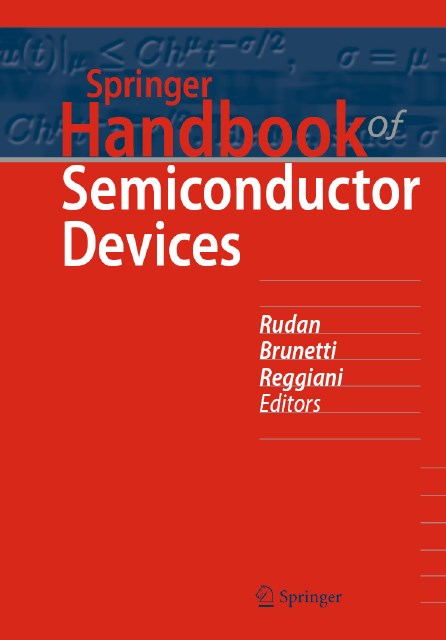Massimo Rudan, Rossella Brunetti, Susanna Reggiani (Eds.)
Springer Handbook of Semiconductor Devices
Series: Springer Handbooks
1st ed., 2022, ca. 1700 p., 1300 illus.
Order online at link.springer.com or customerservice@springernature.com
- Covers physical backgrounds, fabrication, application and modeling
- Describes in detail both conventional and innovative devices
- An indispensable resource for practitioners, professionals and researchers
This Springer Handbook comprehensively covers the topic of semiconductor devices, embracing all aspects from theoretical background to fabrication, modeling, and applications.
Nearly 100 leading scientists from industry and academia were selected to write the handbook's chapters, which were conceived for professionals and practitioners, material scientists, physicists and electrical engineers working at universities, industrial R&D, and manufacturers.
Starting from the description of the relevant technological aspects and fabrication steps, the handbook proceeds with section fully devoted to the main conventional semiconductor devices like, e.g., bipolar transistors and MOS capacitors and transistors, used in the production of the standard integrated circuits, and the corresponding physical models. In the subsequent chapters, the scaling issues of the semiconductor-device technology are addressed, followed by the description of novel concept-based semiconductor devices. The last section illustrates the numerical simulation methods ranging from the fabrication processes to the device performances.
Each chapter is self-contained, and refers to related topics treated in other chapters when necessary, so that the reader interested in. specific subject can easily identify personal reading path through the vast contents of the handbook.
Technological aspects
Basic devices and applications
New-generation devices and architectures
Modeling
CMOS Manufacturing processes. Semiconductor memory technologies. BCD process technologies. Measuring techniques for the semiconductor's parameters. Interconnect Processing: Integration, Dielectrics, Metals. Wet Chemical Processes for BEOL Technology. From FinFET to nanosheets and beyond. Advanced Lithography. Advanced technologies for future materials and devices
Basic devices and applications
MOS Capacitors, MOS Transistors and Charge-Transfer Devices. Electrostatic doping and devices. Planar MOSFETs and their application to IC design. Silicon power devices. Silicon Carbide Power Devices. GaN- based lateral and vertical devices. Bipolar transistors and silicon diodes. Memory Challenges. Silicon sensors. Solar Cells. X-ray detectors. Photodetectors based on Emerging Materials. Terahertz Electronic Devices. Semiconductor Lasers
New-generation devices and architectures
Heterojunction tunnel field-effect transistors. Carbon based field-effect transistors. Negative capacitors and applications. Flexible Electronics and Biomedical Sensors. Bio-Degradable Electronics. Resistive Switch- ing Memories. Phase-Change Memories. Spin-Based Devices for Digital Applications. Memristive/CMOS devices for neuromorphic applications. Nanoelectronic Systems for quantum computing
Modeling
Compact/SPICE Modeling. Process simulation. A digital twin for MEMS and NEMS. Macroscopic Transport Models for Classical Device Simulation. Grid generation and Algebraic solvers. Spherical Harmonics Expansion and Multi-Scale Modeling. Charge Transport Models for Amorphous Chalcogenides. Application of the k.p method to device simulation. Ab initio methods for electronic transport in semiconductors and nanostructures. Quantum Transport in the Phase Space, the Wigner Equation. The Non-Equilibrium Green Function (NEGF) Method. Tight-Binding Models, their Applications to Device Modeling and Deployment to. Global Community



